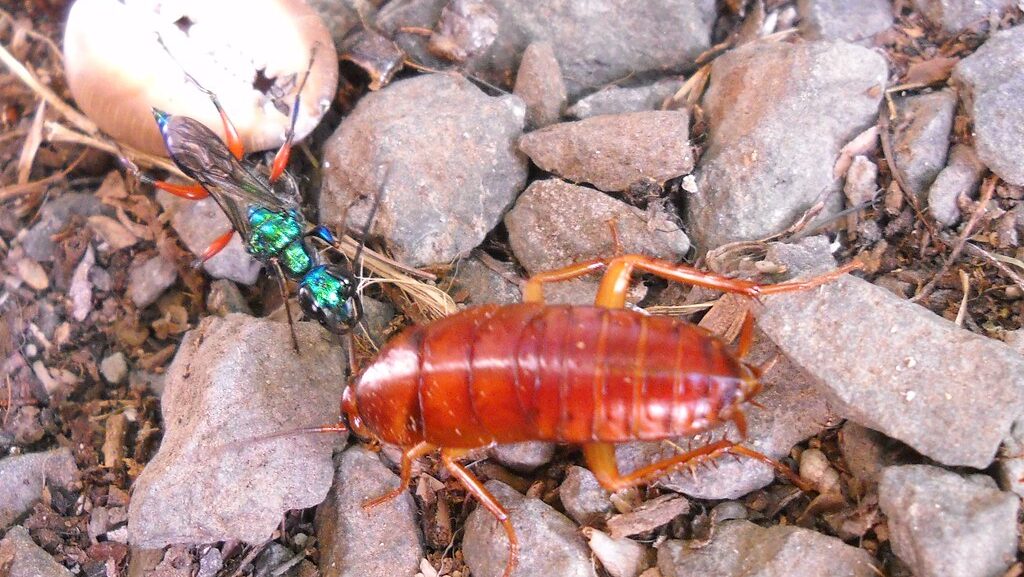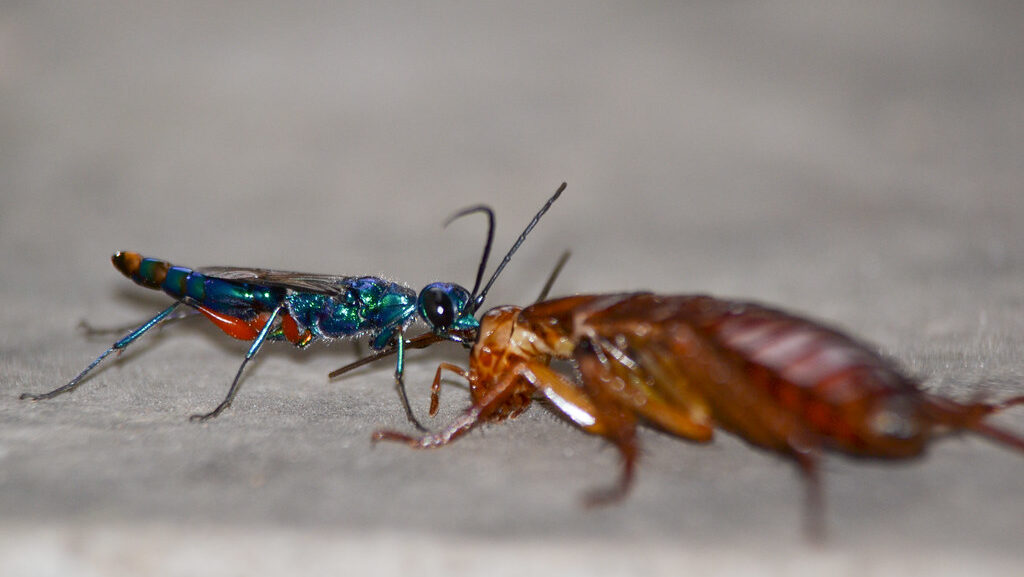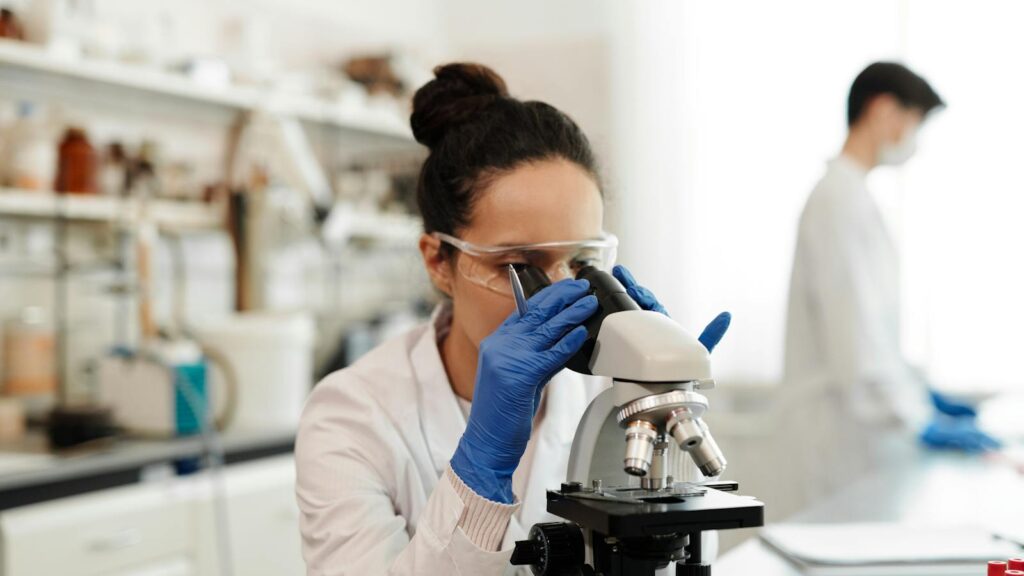In the vast theater of nature’s predator-prey relationships, few performances are as macabre and fascinating as the interaction between the jewel wasp (Ampulex compressa) and its unfortunate cockroach victims. This emerald-green parasitoid wasp, no larger than a paperclip, performs one of the most precise neurosurgical procedures in the animal kingdom—turning cockroaches into mindless zombies before transforming them into living nurseries for wasp offspring. The process of “mummification” isn’t just a gruesome curiosity; it represents millions of years of evolutionary refinement and offers scientists insights into brain function, behavioral manipulation, and the extreme adaptations that emerge from evolutionary arms races. This remarkable predatory strategy has captivated biologists, neuroscientists, and evolutionary researchers alike, providing a window into the sophisticated biological mechanisms that have evolved in the insect world.
The Jewel Wasp: Nature’s Neurosurgeon

The jewel wasp, with its metallic blue-green exoskeleton, is as beautiful as it is deadly—at least if you’re a cockroach. Native to the tropical regions of Africa, India, and the Pacific Islands, this solitary wasp has evolved highly specialized hunting behaviors targeting cockroaches, particularly the American cockroach (Periplaneta americana). Unlike many predatory insects that kill their prey outright, the jewel wasp requires its victim to remain alive but compliant. The female wasp possesses a stinger that functions not just as a weapon but as a precision injection system, delivering venom directly into specific ganglia within the cockroach’s nervous system. This remarkable anatomical equipment allows the wasp to perform what amounts to brain surgery without formal training, locating tiny neurological targets within the cockroach’s head with astonishing accuracy—a feat made all the more impressive considering the wasp’s brain is smaller than a grain of rice.
The First Strike: Temporary Paralysis

The jewel wasp’s attack begins with a carefully coordinated approach to its much larger prey. Despite cockroaches being equipped with excellent sensory apparatus designed to detect predators, the wasp manages to get close enough to launch its two-stage attack. The first strike targets the cockroach’s thorax, where the wasp delivers a precise sting to the first thoracic ganglion—a cluster of nerve cells that control the front legs. This initial injection contains a cocktail of neurotoxins that temporarily paralyze the cockroach’s front legs, preventing the insect from running away or defending itself effectively. This paralysis lasts just long enough—about 30 seconds—for the wasp to position itself for the second, more intricate phase of its attack. The precision of this initial strike demonstrates the wasp’s sophisticated hunting strategy, where temporary immobilization serves as preparation for the more complex neurological manipulation to follow.
The Second Sting: Mind Control Through Neurotoxins

With the cockroach partially immobilized, the jewel wasp executes the most remarkable aspect of its attack—a second, precisely targeted sting directly into the cockroach’s brain. The wasp inserts its stinger through the soft tissue of the neck and into the cerebral ganglia, specifically targeting two areas: the subesophageal ganglion and the central complex. These brain regions control both voluntary movement and the escape response in cockroaches. The venom cocktail injected here contains a complex mixture of neurotoxins including dopamine-like compounds and GABA (gamma-aminobutyric acid) receptor blockers that effectively “hijack” the cockroach’s brain. Rather than killing the cockroach, these compounds block octopamine (a neurotransmitter essential for insect motivation) and suppress the insect’s escape reflex while leaving vital functions intact. The result is a cockroach that maintains normal metabolic functions but loses all motivation to move independently or resist manipulation—essentially becoming a living zombie at the wasp’s disposal.
The Zombification Process

Following the brain injection, the cockroach enters a bizarre state that scientists call “hypokinesia”—a condition where it can still move all its limbs but loses the will to initiate movement on its own. The once alert and reactive cockroach becomes docile and compliant, no longer responding to threats that would normally trigger immediate escape. In a particularly telling experiment, researchers demonstrated that a zombified cockroach will not flee even when placed in a well-lit area, despite cockroaches’ strong natural aversion to light. The wasp’s venom doesn’t damage the cockroach’s motor skills; rather, it specifically targets the motivation centers of the brain. This selective manipulation represents an evolutionary masterpiece—the wasp needs its victim alive and physically functional, yet behaviorally compliant. The zombification process typically lasts about 30 minutes, during which the cockroach transitions from an independent organism to a passive puppet, awaiting the next stage in the wasp’s reproductive strategy.
The Bizarre “Leash” Behavior

Once the cockroach has been rendered compliant, the jewel wasp engages in one of the strangest behaviors in the insect world—it literally leads its victim by the antennae like a dog on a leash. After the venom takes full effect, the wasp bites off about one-third of each of the cockroach’s antennae. This seemingly destructive act serves a crucial purpose: it creates handles that the wasp uses to guide its zombie victim. The wasp grabs what remains of one antenna with its mandibles and tugs, steering the much larger cockroach toward the wasp’s nest, which may be located up to 15 meters away. The docile cockroach follows willingly, walking under its own power but completely under the wasp’s directional control. This “leash” behavior represents a remarkable case of interspecies manipulation, where the parasite effectively commandeers the host’s locomotion systems while bypassing its decision-making processes. The sight of a tiny wasp leading a cockroach many times its size is one of nature’s most surreal spectacles and demonstrates the extraordinary behavioral control the wasp exerts over its victim.
The Living Larder: Creating a Fresh Food Supply

The jewel wasp’s manipulation of the cockroach serves a single evolutionary purpose: providing fresh food for its offspring. Unlike predators that kill and consume their prey immediately, or parasites that gradually feed on a living host, the jewel wasp transforms its victim into what scientists call a “living larder”—essentially a food preservation system. By keeping the cockroach alive but immobile, the wasp ensures that its offspring will have access to fresh nutrients rather than decaying tissue. This strategy solves a significant problem for insects that provision their young: how to keep food from spoiling before it can be consumed. The cockroach, with its metabolism still functioning normally, continues to process nutrients and maintain its tissues, essentially serving as a self-maintaining food source. From an evolutionary perspective, this represents an elegant solution to food preservation in environments where decomposition occurs rapidly, allowing the wasp to provide its offspring with optimal nutrition without requiring additional hunting or provisioning behaviors.
The Wasp’s Nest: An Underground Tomb

After successfully leading its zombie victim to an appropriate location, the jewel wasp prepares a nest—typically a small burrow or chamber in soil or rotting wood. The wasp may either excavate this chamber itself or use a pre-existing cavity, which it modifies to suit its reproductive needs. Once the nest site is prepared, the wasp drags the compliant cockroach inside and positions it carefully within the chamber. With remarkable precision, the wasp then blocks the entrance to the burrow with small pebbles, leaves, or soil particles, effectively sealing both predator and prey inside a dark, underground tomb. This entombment serves multiple purposes: it protects the vulnerable egg and developing larva from predators, maintains appropriate humidity levels for development, and prevents the cockroach—should it somehow recover from its zombified state—from escaping. The careful construction of this burial chamber represents the final preparatory step before the wasp can fulfill its ultimate biological imperative: reproduction.
Egg Laying: The Beginning of Mummification

Within the sealed chamber, the female jewel wasp performs the central act of her reproductive cycle by laying a single white egg on the immobilized cockroach’s leg. The placement is deliberate and precise—typically on the mid-section of one of the cockroach’s legs, where the egg will be relatively protected while maintaining contact with the host. After depositing her egg, the mother wasp exits the burrow, reseals it, and abandons both her offspring and its living food supply to their fate. The wasp will never see its offspring; her parental investment ends with the provision of this living incubator and food source. The egg, measuring just a few millimeters in length, contains all the genetic information needed for the next generation of this remarkable parasitoid. Within approximately three days of being laid, the egg hatches into a tiny, worm-like larva—beginning the true mummification process that will gradually transform the living cockroach into a hollow shell.
The Hatching Larva’s First Meal

When the wasp egg hatches, the emerging larva faces an immediate challenge: it must feed without killing its host prematurely. The newly hatched larva solves this problem through an initial feeding strategy that is both gruesome and sophisticated. The tiny grub-like creature first creates a small hole in the cockroach’s exoskeleton, usually near where the egg was attached. Through this opening, the larva begins to feed on the cockroach’s hemolymph—the insect equivalent of blood—which provides nutrition without damaging vital organs. This hemolymph meal is rich in proteins and nutrients while being easily accessible to the small larva. The strategic consumption of hemolymph allows the larva to grow stronger while ensuring the cockroach remains alive and its tissues fresh. During this initial feeding stage, which lasts approximately 3-4 days, the cockroach shows few external signs of being consumed from within, while the larva grows rapidly in preparation for the next, more invasive stage of development.
Entering the Body Cavity: The Point of No Return

After several days of external feeding, the growing wasp larva takes a dramatic and irreversible step: it burrows directly into the cockroach’s abdomen. Using specialized mandibles, the larva creates an entry wound and pushes its entire body into the cockroach’s internal cavity. Once inside, the larva positions itself strategically among the cockroach’s organs and begins consuming them in a carefully orchestrated sequence. Remarkably, the larva first consumes non-vital tissues and less essential organs, deliberately avoiding the nervous system and respiratory structures. This selective feeding ensures the cockroach remains alive as long as possible, continuing to supply oxygen to its tissues even as it’s being devoured from within. The internal feeding stage represents the true beginning of mummification, as the cockroach is gradually hollowed out while its external shell remains intact. Throughout this process, the cockroach exhibits few signs of distress—a testament to the sophisticated neurological manipulation initiated by the mother wasp’s venom days earlier.
The Final Consumption: Saving the Vital Organs for Last

As the wasp larva grows larger within its living host, it continues its methodical consumption of the cockroach’s internal structures according to a genetically programmed sequence. The larva consumes fat bodies, digestive organs, and muscle tissue before finally moving on to the vital organs necessary for the cockroach’s survival. This feeding order is not random but represents an evolved strategy to maximize the nutritional value obtained from the host while extending its survival time. Only when the larva has nearly completed its development does it finally consume the cockroach’s vital organs—the heart and central nervous system—resulting in the host’s death. This delayed mortality maximizes the freshness of the cockroach’s tissues throughout the larval development period. By the time the cockroach finally dies, approximately 7-10 days after the initial wasp attack, its body has been almost completely hollowed out, with only the exoskeleton and some structural elements remaining intact—a true insect mummy.
Pupation: The Transformation Within a Transformation

After consuming virtually all of the cockroach’s internal tissues, the well-fed wasp larva enters the pupation phase of its development. Remaining safely inside the protective shell of the cockroach’s exoskeleton, the larva spins a silken cocoon around itself within what was once the cockroach’s body cavity. This cocoon provides additional protection during the vulnerable metamorphosis process that follows. Within this dual protection system—the cocoon inside the cockroach mummy—the larva undergoes complete metamorphosis, reorganizing its body from a simple, worm-like grub into the complex adult form of the jewel wasp. During this remarkable transformation, which takes approximately 4-5 weeks, the developing wasp breaks down most of its larval tissues and rebuilds them into adult structures—including compound eyes, segmented legs, functional wings, reproductive organs, and the specialized venom apparatus it will need to continue the cycle. The cockroach’s mummified remains serve as both protective shelter and nutritional reserves throughout this extended development period.
Emergence: The Cycle Begins Anew

After completing its metamorphosis, the fully formed adult jewel wasp awakens within the desiccated husk of what was once a living cockroach. Using its powerful mandibles, the new wasp cuts through both its silken cocoon and the remaining cockroach exoskeleton, creating an exit hole through which it emerges into the outside world. This emergence typically occurs approximately 6-8 weeks after the original egg was laid, representing the completion of one generation in the wasp’s life cycle. The newly emerged adult is fully equipped with all the complex anatomical and behavioral adaptations needed to find mates and, if female, to hunt cockroaches and continue the remarkable parasitoid cycle. Within hours of emergence, the wasp’s exoskeleton hardens and takes on the characteristic metallic blue-green coloration that gives the species its common name. After a brief period of maturation, female wasps will begin hunting for cockroaches, armed with the same sophisticated venom and behavioral programming that allowed their mother to create the very mummy from which they emerged.
Evolutionary Significance: An Arms Race Written in Genes

The jewel wasp’s mummification strategy represents the current state of an evolutionary arms race between predator and prey that has likely been ongoing for millions of years. The extraordinary precision of the wasp’s hunting technique suggests strong selective pressure has refined this behavior over countless generations. Cockroaches, as one of Earth’s most successful and ancient insect groups, possess numerous defensive adaptations including rapid escape responses, sensory awareness, and physical durability. The jewel wasp’s evolution of precise neurosurgical techniques and complex venom compounds represents a series of adaptations specifically designed to overcome these defenses. This predator-prey relationship demonstrates coevolutionary principles in action, where improvements in prey defense mechanisms drive counter-adaptations in predators. Molecular evidence suggests the compounds in jewel wasp venom have undergone accelerated evolution, indicating strong positive selection for more effective manipulation toxins. The mummification strategy ultimately represents a remarkable example of how natural selection can produce behaviors and physiological mechanisms of astonishing complexity when driven by the relentless pressure to survive and reproduce.
Medical and Scientific Applications

Beyond its evolutionary significance, the jewel wasp’s relationship with cockroaches has captured the attention of researchers in fields ranging from neuroscience to pharmacology. The wasp’s venom contains compounds that act with remarkable specificity on particular neural pathways, making it valuable for understanding brain function and developing potential therapeutic agents. Scientists have identified and synthesized several peptides from jewel wasp venom that show promise for treating conditions involving dopamine dysregulation, including Parkinson’s disease and certain psychiatric disorders. The wasp’s precision in targeting specific ganglia has also inspired advances in microsurgical techniques and the development of miniaturized medical instruments. Additionally, understanding how the wasp’s venom manipulates cockroach behavior has provided insights into the neural basis of motivation and decision-making in insects, with potential applications for pest control strategies that target behavior rather than simply killing target organisms. The jewel wasp’s mummification strategy, evolved over millions of years, may ultimately contribute to solving human medical challenges in the twenty-first century.
Conclusion
The jewel wasp’s mummification
